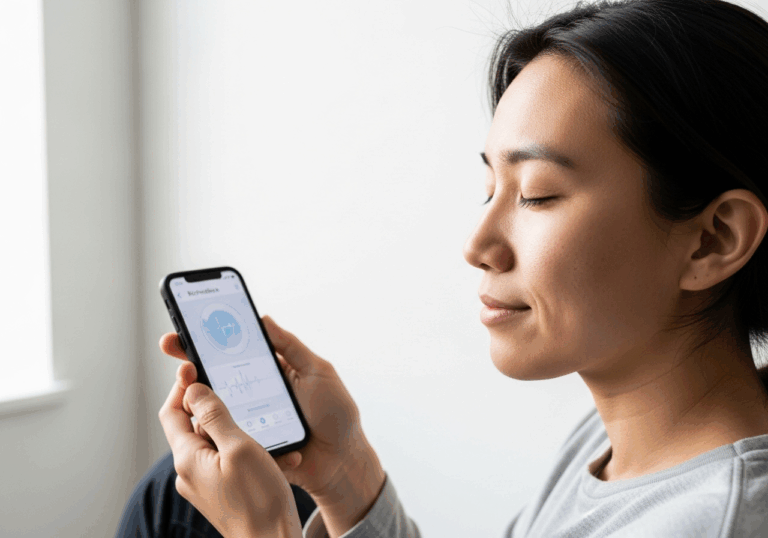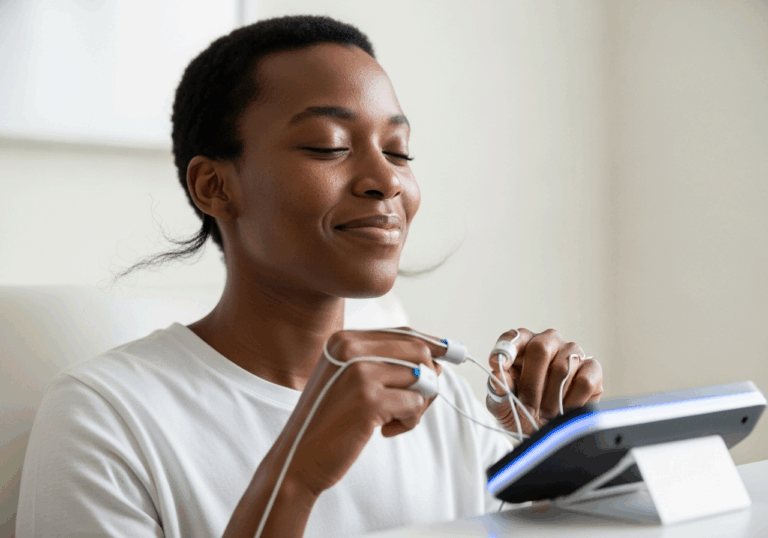Science-Backed Tips
Enhance Calm with Heart Rate Variability Biofeedback
20% reduction in respiratory rate improves mood states.
📊 Did you know?
💡 Why It Matters
1️⃣
A 20% reduction in respiratory rate can lead to lower stress levels and improved emotional wellbeing.
2️⃣
Improved heart rate variability is associated with better cardiovascular health and resilience to stress.
3️⃣
Biofeedback training can be a cost-effective intervention for managing anxiety and stress-related disorders.
✅ Try These Micro-Tips
🎯
Engage in 5 weekly heart rate variability biofeedback sessions for optimal results.
🎯
Practice deep breathing exercises for 10 minutes daily to enhance respiratory function.
🎯
Monitor your mood and stress levels before and after sessions to track improvements.
🎯
Incorporate mindfulness practices alongside biofeedback for enhanced emotional regulation.
📚 The study
The implications of these findings are profound; a slower breathing rate can acutely lower arousal levels, which in turn enhances mood and emotional wellbeing.
For frontline healthcare workers, who often face high-stress environments, this cost-effective intervention offers a promising strategy for managing anxiety and stress-related disorders. Improved HRV is linked to better cardiovascular health and greater resilience to stress, making HRVB training a valuable tool in promoting overall mental and physical health.
As we continue to explore innovative methods for stress management, the results of this study underscore the importance of integrating biofeedback techniques into wellness programs, particularly for those in high-pressure occupations. By fostering a calmer state of mind through controlled breathing, individuals can not only improve their emotional state but also enhance their overall quality of life.
❓ Frequently Asked Questions ❓
Learn more
What is heart rate variability biofeedback (HRVB)?
HRVB is a training method that teaches individuals to control their heart rate variability through breathing techniques. It aims to improve emotional regulation and reduce stress levels by enhancing autonomic nervous system function.
How does HRVB training affect respiratory rate?
HRVB training has been shown to slow the respiratory rate by approximately 20%. This reduction in breathing rate is associated with decreased sympathetic arousal and improved mood states.
What are the benefits of a slower respiratory rate?
A slower respiratory rate can lead to lower stress levels and enhanced emotional well-being. It helps in calming the nervous system and promoting a sense of relaxation.
How many sessions of HRVB training are recommended for optimal results?
Engaging in five weekly HRVB sessions is recommended for optimal results. This structured approach allows for significant improvements in respiratory rate and heart rate variability.
Can HRVB training help with anxiety and stress-related disorders?
Yes, HRVB training can be a cost-effective intervention for managing anxiety and stress-related disorders. It equips individuals with tools to better regulate their emotional responses.
What role does heart rate variability (HRV) play in health?
Improved heart rate variability is associated with better cardiovascular health and increased resilience to stress. Higher HRV indicates a well-functioning autonomic nervous system and better emotional regulation.
How can I track my progress during HRVB training?
Monitoring your mood and stress levels before and after HRVB sessions can help track improvements. Keeping a journal or using an app can provide insights into your emotional and physiological changes.
What additional practices can enhance the effects of HRVB training?
Incorporating mindfulness practices alongside HRVB can enhance emotional regulation. Techniques such as meditation or yoga can complement the benefits gained from biofeedback training.
How long should I practice deep breathing exercises daily?
Practicing deep breathing exercises for 10 minutes daily is recommended to enhance respiratory function. This practice can further support the benefits gained from HRVB training.
What is the significance of improved mood states following HRVB training?
Improved mood states following HRVB training signify a reduction in sympathetic arousal, leading to a calmer emotional state. This can contribute to overall well-being and better stress management.





